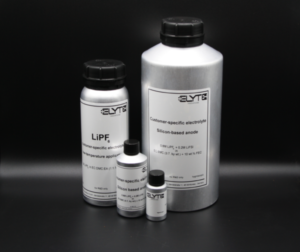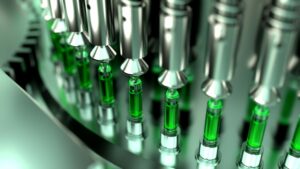
Electrolytes for high voltage applications
Electrolyte salt: LiPF₆, LiFSI, LiTFSI
Solvent: EC, DEC, EMC, fluorinated Ether, fluorinated Carbonates, Nitrile (composition according to request and requirement)
Batch sizes: 25 g – 2 kg (bigger amounts available on request )
Packaging Electrolyte: UN-safety aluminum bottles (made in Germany), sealed in pouch bags under an inert gas atmosphere
Packaging Bottle: UN-certified dangerous goods cartons in compliance with ADR
Delivery time within EU: maximum 14 days
If you are interested in our electrolyte, please send us an inquiry to contact@e-lyte-innovations.de or use our contact form:
Characteristics of electrolytes for high voltage applications
Higher Li-ion battery energy densities are achievable by increased charging voltages (>4.3 V vs. Li+/Li) however, such approach goes hand in hand with risking of safety and reduction of cycle life. The positive electrode active materials with layered oxide crystalline structures, like NCM, are not stable beyond a certain de-lithiation degree and transform into electrochemically inactive phases upon high voltage charging. Associated with that, transition metal dissolution of the positive electrode may drastically alter the SEI species once migrated through the electrolyte and deposited at the negative electrode side, known as the “cross-talk” phenomenon. This situation depletes the active lithium species either by immobilization within the SEI or further formation of Li dendrites, leading to rapid fading of the capacity (rollover failure).
EC-based conventional electrolytes are highly unstable against high-voltage positive electrodes due to their initially low anodic stability beyond 4.3 V vs. Li+/Li. Beyond this voltage, the solvent oxidizes and polymerizes as polycarbonate species on the de-lithiated layered positive electrode materials as a component of the CEI (cathode electrolyte interphase), which is also not stable at high voltage. High voltage electrolytes must, therefore, must operate either by promoting the formation of a protective film on the positive electrode surface or by hindering the dissolution of the ions comprising the layered positive material structure.
Application fields
High voltage withstanding electrolytes are applied to improve the operating voltage or the capacity of the Li-ion batteries.


